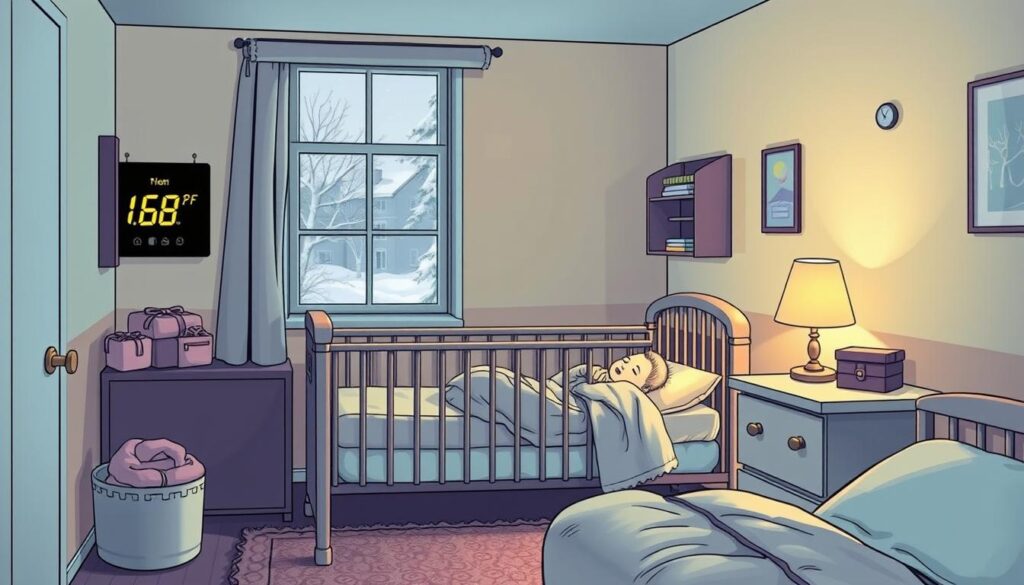Best Winter Sleep Tips for Babies
Did you know that over 60% of parents report their babies experiencing disrupted sleep patterns during the winter months? The colder temperatures and reduced daylight hours can significantly impact an infant’s circadian rhythm and sleep-wake cycle. As a parent, navigating your little one’s winter sleep needs is crucial for their overall health and development. In this comprehensive guide, we’ll explore proven strategies to help your baby sleep soundly all season long.
Key Takeaways
- Understanding how winter affects baby sleep patterns is essential for creating a cozy and comfortable environment.
- Implementing optimal room temperature settings and draft prevention measures can significantly improve sleep quality.
- Dressing your baby in appropriate winter attire and using safe bedding options are critical for maintaining a comfortable sleep environment.
- Monitoring your baby’s temperature and adjusting feeding strategies during cold weather can help ensure their safety and well-being.
- Maintaining a consistent sleep routine and creating a soothing sleep environment can help your baby adapt to the seasonal changes.
Understanding Baby Sleep Patterns in Winter
As the colder months approach, it’s crucial to understand how the changing seasons can impact your baby’s sleep patterns. The circadian rhythm, the internal biological clock that regulates sleep-wake cycles, can be significantly affected by the reduced daylight that comes with winter.
Circadian Rhythm Changes During Cold Months
During the winter, the shorter days and longer nights can disrupt your baby’s natural sleep-wake cycle. Infants’ circadian rhythms are particularly sensitive to changes in light exposure, and the decreased daylight can lead to a delay in the release of melatonin, the hormone that promotes sleep.
Impact of Reduced Daylight on Sleep
The reduced daylight experienced during the winter months can have a profound effect on your infant’s sleep cycles. Babies may struggle to fall asleep at their regular bedtime and may experience more frequent night wakings due to the changes in their internal clock.
Natural Sleep Cycles for Infants
Infants have unique sleep patterns that are different from older children and adults. Newborns, for example, may sleep up to 17 hours a day, with short periods of wakefulness throughout the day and night. As your baby grows, their sleep cycles will become more established, but the winter season can still disrupt these natural rhythms.
Understanding the impact of seasonal changes on your baby’s sleep patterns can help you better anticipate and address any challenges that may arise during the winter months.
Optimal Room Temperature Settings
Maintaining the right room temperature is crucial for your baby’s comfortable and restful sleep during the winter months. The ideal temperature range for a baby’s sleep environment should be between 68°F and 72°F (20°C to 22°C). This temperature range helps ensure your little one stays warm without becoming overheated.
Consistency is key when it comes to room temperature. Fluctuations in temperature can disrupt your baby’s circadian rhythm and lead to poor sleep quality. Aim to keep the room temperature as stable as possible throughout the night.
While ensuring optimal temperature control, it’s also important to consider energy efficiency. Use a programmable thermostat or smart home technology to automate temperature adjustments, helping to maintain the ideal setting while minimizing energy consumption. You can also explore insulation techniques to retain heat and prevent cold room challenges.
| Temperature Range | Benefits |
|---|---|
| 68°F to 72°F (20°C to 22°C) | Provides a comfortable and safe sleep environment for babies during the winter |
| Below 68°F (20°C) | Increases the risk of hypothermia and disrupts sleep |
| Above 72°F (22°C) | Increases the risk of overheating and SIDS |
By maintaining the optimal room temperature and incorporating energy-efficient strategies, you can create a cozy and healthy sleep environment for your baby throughout the winter season.

Cold Room Challenges and Solutions
As the temperatures drop outside, baby’s nursery can become a cold and uncomfortable environment, posing challenges to their restful sleep. Addressing these cold room issues is crucial for ensuring your little one stays cozy and well-rested throughout the winter months.
Managing Draft Prevention
Drafts can be a significant problem in cold rooms, creating an unpleasant chill that disrupts baby’s sleep. To manage draft prevention, consider installing door sweeps and weatherstripping around windows and doors to seal any gaps and cracks. These simple measures can significantly improve the insulation in the room, keeping the warm air in and the cold air out.
Heating System Considerations
Choosing the right heating system for baby’s room is crucial for maintaining a comfortable temperature. Opt for a reliable and energy-efficient heating solution, such as a space heater or a zone-controlled heating system, to ensure the room stays warm without overheating. Remember to always follow safety guidelines and never leave a heating device unattended.
Window Insulation Tips
Windows can be a significant source of heat loss in a cold room. Improve the insulation by installing thermal curtains or blackout blinds, which can help trap the warm air inside and prevent drafts. You can also consider installing storm windows or applying window film to create an additional barrier against the cold.
By addressing these cold room challenges with effective solutions, you can create a cozy and comfortable sleep environment for your little one, ensuring they stay warm and well-rested throughout the winter season.
| Home Exterior Maintenance | Benefits |
|---|---|
| Cleaning Siding | Prevents paint deterioration or stains during winter months |
| Gutter Maintenance | Prevents water damage and ice dams, ensuring better long-term home protection |
| Paint Touch-Ups | Protects siding from moisture damage, avoiding swelling, warping, and rot |
| Storm Windows | Improves insulation, lowers energy bills, and protects existing windows during harsh winter weather |
| Roof Inspections | Prevents leaks, ice dams, and costly damage from snow, ice, and rain |
| Sealing Windows and Doors | Reduces heat loss, lowers energy bills, and protects homes from moisture damage |
| Siding Maintenance | Regular checks, repairs, and caulk replacements help prevent water damage, mold, rot, or siding issues during winter |
Dressing Your Baby for Winter Sleep
As the temperature drops and winter sets in, it’s crucial to ensure your baby is appropriately dressed for comfortable and safe sleep. Striking the right balance between keeping them warm and preventing overheating is key to promoting healthy sleep patterns during the colder months.
When it comes to winter sleep tips, layering is the key. Start with a lightweight, breathable base layer, such as a onesie or a thermal undershirt, to maintain your baby’s core body temperature. Add a cozy, but not too thick, outer layer like a footed sleeper or a sleep sack. Remember, the temperature control is essential – you want your baby to be warm, but not too hot.
- Opt for natural fabrics like cotton or wool, which help regulate body temperature.
- Avoid overdressing your baby, as this can lead to sweating and discomfort, disrupting their sleep.
- Monitor your baby’s temperature and adjust their clothing accordingly. If their hands or feet feel cold, add an extra layer.
Sleep sacks and wearable blankets can be excellent options for keeping your baby warm while ensuring their safety. These garments are designed to allow for movement while preventing the risk of suffocation or strangulation. Always follow the manufacturer’s guidelines and safety recommendations when using these items.
By dressing your baby appropriately for winter sleep, you can help ensure they stay comfortable, cozy, and well-rested throughout the colder months. Regularly checking their temperature and making adjustments to their clothing as needed will help maintain the ideal sleep environment for your little one.
Creating a Cozy Sleep Environment
Ensuring a comfortable and safe sleep environment is crucial for your baby’s well-being during the winter months. From selecting the right bedding to managing humidity levels and air quality, there are several steps you can take to create a cozy and nurturing sleep space.
Safe Bedding Options
When it comes to safe bedding, choose fabrics that are breathable and free from any loose parts or ties that could pose a suffocation risk. Opt for natural fibers like cotton or wool, and avoid heavy blankets or duvets that could restrict your baby’s movement. Consider using a wearable blanket or sleep sack to keep your little one warm without the risk of entanglement.
Humidity Control Methods
Maintaining the proper humidity level in your baby’s room is crucial during the winter. Low humidity can lead to dry skin, static electricity, and respiratory issues, while high humidity can promote the growth of mold and mildew. Use a humidifier or dehumidifier to keep the humidity between 30-50% for a comfortable and healthy sleep environment.
Air Quality Management
Good air quality is essential for your baby’s restful sleep. Ensure regular ventilation by opening windows, even briefly, to introduce fresh air. Consider using an air purifier to remove any pollutants, allergens, or contaminants that could affect your baby’s breathing and sleep quality.
By creating a safe, comfortable, and well-regulated sleep environment, you can help your baby enjoy a cozy and restful winter slumber.
Night Feeding Strategies in Cold Weather
Maintaining a warm and comfortable environment during night feedings can be a challenge, especially in the colder winter months. However, with the right strategies, you can minimize disruption to your baby’s sleep and ensure both of you stay cozy and content throughout the nighttime care routines.
Night feeding can be particularly tricky in cold weather, as the transition from a warm bed to a chilly room can be jarring for your little one. To combat this, try these tips:
- Preheat the feeding area before starting, whether it’s your baby’s nursery or a cozy corner of your bedroom. Use a space heater or electric blanket to take the chill off the air.
- Dress your baby in warm, lightweight layers that can be easily removed during the feeding. Opt for soft, breathable fabrics like cotton or bamboo.
- Keep a warm, snuggly blanket nearby to wrap your baby in after the feeding, ensuring they stay toasty until they drift back to sleep.
- Consider investing in a feeding pillow or nursing chair with built-in lumbar support to help you and your baby stay comfortable during the cold weather challenges of night feeding.
By taking these proactive measures, you can create a cozy, calming environment that promotes peaceful, uninterrupted feedings, even on the chilliest winter nights. With a little preparation, you and your baby can enjoy the warmth and comfort of these precious nighttime bonding moments.
| Scenario | Temperature Considerations | Recommended Solutions |
|---|---|---|
| Feeding in a cold nursery | Overnight lows in the 30s |
|
| Nighttime feeding in the master bedroom | Chilly drafts from windows |
|

By following these strategies, you can ensure your baby stays warm, comfortable, and well-rested during thenight feedingprocess, even in thecold weather challengesof winter.
Safety Measures for Winter Baby Sleep
As the temperatures drop during the winter months, it’s crucial to prioritize safety measures to ensure your baby’s well-being during sleep. Two key aspects to consider are SIDS prevention and proper room ventilation.
SIDS Prevention in Cold Weather
Sudden Infant Death Syndrome (SIDS) is a devastating concern for parents, and it’s essential to take extra precautions during the colder season. SIDS prevention remains a top priority, even in the winter. Adhering to safe sleep practices, such as placing your baby on their back to sleep, using a firm mattress, and avoiding loose bedding or soft objects in the crib, can greatly reduce the risk of SIDS.
Room Ventilation Guidelines
Proper room ventilation is crucial to maintain a healthy sleep environment for your baby. Ensure the room is well-ventilated by opening windows regularly, even in the winter, to allow for fresh air circulation. This helps prevent the buildup of carbon dioxide and stale air, which can be particularly concerning during the colder months when windows may be closed more often.
Emergency Preparedness Tips
In the event of power outages or extreme weather conditions, it’s essential to have a backup plan to maintain a safe sleep environment for your baby. Emergency preparedness measures such as investing in a battery-powered or hand-cranked ventilation system can help ensure your baby’s room remains well-ventilated during emergencies.
By incorporating these safety measures into your baby’s winter sleep routine, you can provide a cozy and secure environment for your little one to rest and thrive, even in the colder seasons.
Monitoring Baby’s Temperature
Keeping a close eye on your baby’s body temperature is crucial during the cold winter months. While the World Health Organization recommends a home temperature of 18°C (64.4°F) to protect the general population, health experts suggest setting the thermostat to at least 20°C (68°F) to ensure your little one stays warm and safe.
Regular temperature checks are essential, especially in colder environments. Signs of overheating, such as flushed cheeks, rapid breathing, or sweating, as well as signs of being too cold, like shivering or a low body temperature, should be monitored closely. By adjusting the room temperature or your baby’s clothing based on these observations, you can maintain a comfortable and safe sleep environment.
Remember, exposure to temperatures below 18°C can increase the risk of mold growth and have negative health effects, so it’s vital to find the right balance between energy-efficient heating and your baby’s wellbeing. With careful temperature monitoring and proactive adjustments, you can ensure your little one enjoys a cozy and restful winter sleep.







